Most bacon is made from pork. In fact, according to the USDA, bacon is made only from swine. But creative chefs have been known to make bacon from duck breast, turkey breast, boneless leg of lamb, beef, goat, whatever. According to food historians, European peasants in the Middle Ages thought of pork as a rare treat and a sign of affluence. “Bringing home the bacon” was a demonstration of success. “Chewing the fat” became an expression for “having a conversation.”
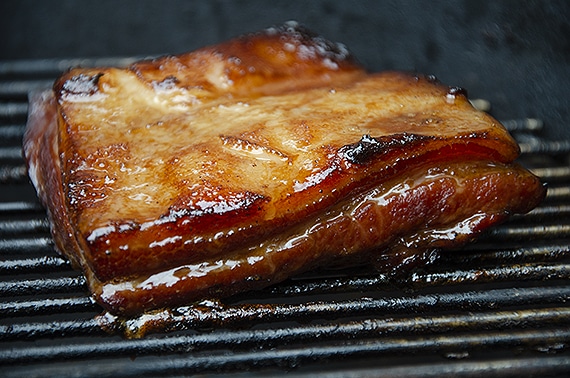
American bacon or streaky bacon is made from the layer of fat and fat streaked meat just below it off the back and side of the hog after the skin is removed. It is usually 1″ to 1 1/2″ thick. Back and side bacon is about 1 part meat to 2 parts fat, and belly is about 1 part meat to 3 parts fat. It is usually cured by injecting with salt and sodium nitrite. The nitrite is called a curing agent, and it kills and prevents botulism bacteria. It also makes meat a distinctive pink color and contributes to its unique flavor. Some producers cure it by wet brining it in a vat of salt and sodium nitrite, and some dry cure it on shelves by coating the surfaces with salt and nitrite. Some cure it in tubs with alternating layers of cure and meat. Some are dry cured with a rub. Black pepper based rubs are popular. Most have some sugar or maple flavor in the cure. After curing, some are smoked, and some get a smoke flavor from liquid smoke. Hickory and apple are the most popular smoking woods. It is usually sliced thin, but some slice it thick. There are a number of small artisan bacon manufacturers in the US who make wonderful crafted meats with creative flavor combinations, exotic woods, and astronomic prices. It must be cooked before eating. But save the drippings rendered during cooking. Bacon fat is wonderfully tasty and makes a superb cooking oil but, like butter, it can burn at high temps. Try pan frying potatoes in bacon fat over moderate heat to see what I mean. And if you hate broccoli, pan fry some in bacon fat and you will change your mind. It is not hard to make, and home made is better than most storebought. Just follow my recipes.
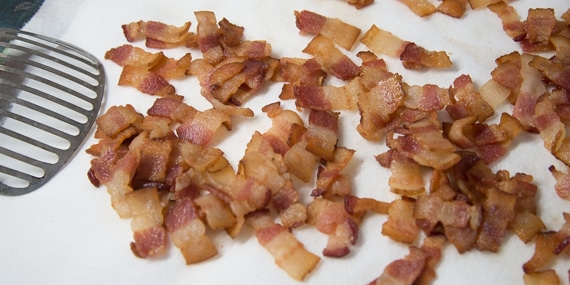
Bacon bits that you buy in the store are often made from soy beans, not pork. If they are made from pork they are usually cooked bacon that is crumbled or, as above, chopped first then cooked.
British bacon is made by taking a boneless pork loin with “nose on” or a bit of fatty belly on one end. It is then cured much like Canadian bacon (below). If you want to make it, use my Canadian Bacon recipe.
Buckboard bacon is pork shoulder, boned, trimmed, cured, and smoked. It is much leaner than side bacon or belly. The meat to fat ratio is about 3:1 or more. If you want to make it, use my Canadian Bacon recipe.
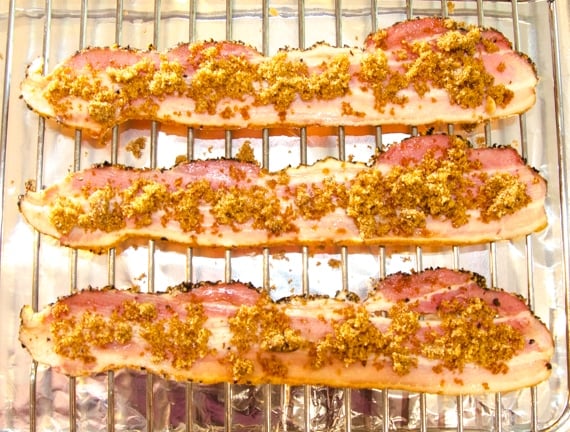
Candied bacon (above) can be made from American bacon. This is brown sugar bacon. At the top of the page are maple bacon and toffee bacon. Click here for three recipes: Brown Sugar Bacon, Toffee Bacon, and Chocolate Mud Pigs.
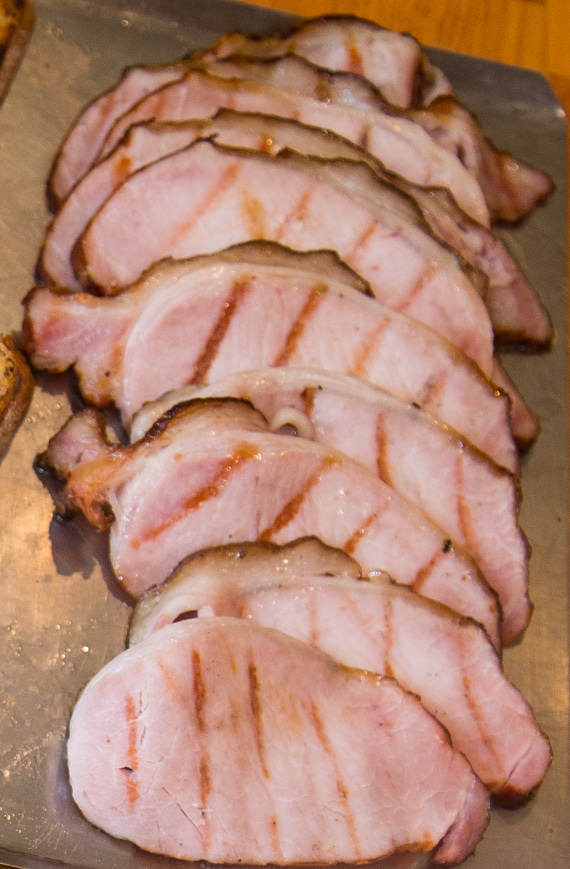
Canadian bacon or Irish bacon or back bacon (above) is made from lean loin meat only, the longissimus dorsi muscle. It is much leaner, at least 10:1 meat to fat, and it is cured in one long thick tube and sliced after. In the US, it is called back bacon. Order boneless loin (not tenderloin) if you want to make this. In Canada you can also find peameal bacon which has been rolled in cornmeal. Click here for a recipe.
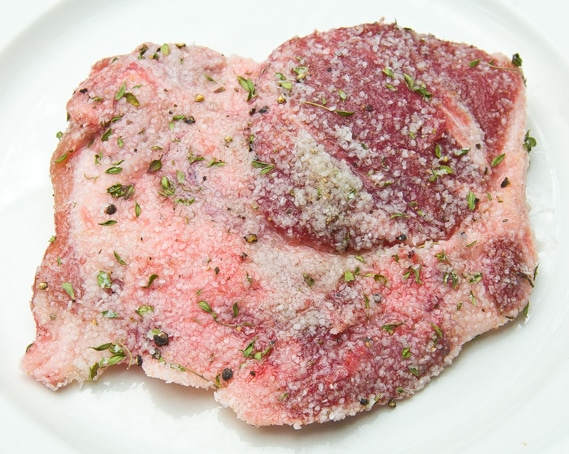
Guanciale or jowls or pork cheek bacon (above). Pretty much any part of the hog and be cured and smoked and sliced for bacon, but cheeks are especially good because they have a nice fat to lean ratio. They are thin and not as fatty, so they normally need only a three to four days in the cure. This is a jowl with a salt and herb cure on it.
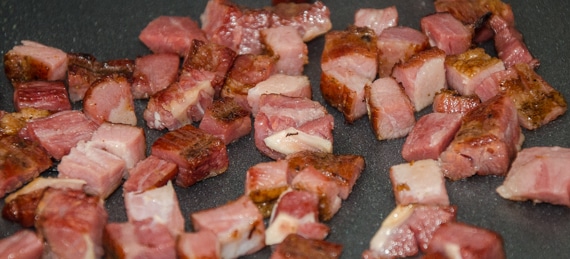
Lardons (above) are little cubes of bacon, great for flavoring other dishes like soups, beans, salads, stir fries, eggs, etc. Just cut slab bacon into cubes. Try this: Cut slab bacon into 3/4″ cubes and heat them in a pan until they are almost done. Then pour in an Asian BBQ sauce, perhaps a huli-huli sauce (a type of teriyaki sauce) or a yakitori sauce and simmer a few minutes. Heck, you can even use a Kansas City style barbecue sauce and make bacon burnt ends!
Pancetta is Italian streaky bacon from belly or side that is cured with salt only and rolled into a log, but not smoked.
Salt pork. According to USDA “Salt pork is not bacon”. Although it is salted, it is much fattier, and, unlike bacon, it is not smoked. It is generally cut from the hog’s belly or side. Because salt pork is so salty, cooks often blanch or soak it to extract some of the salt before using.”
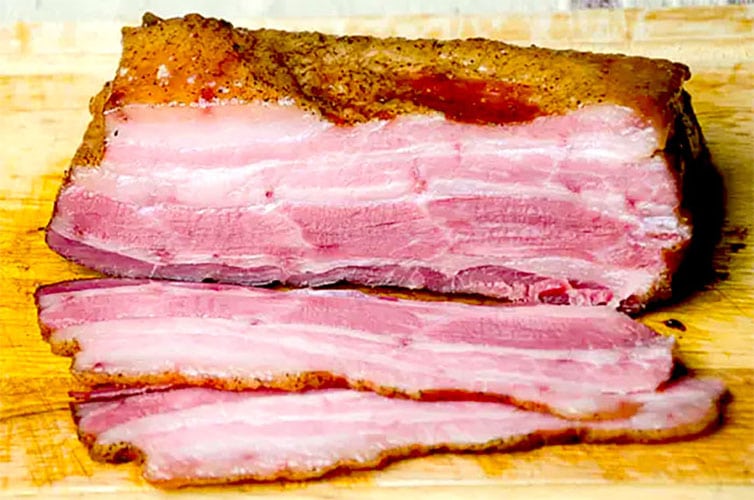
Slab bacon (above) is a large section of side or belly that is cured and smoked, but not sliced.
Speck. In Germany, Austria, and Northern Italy, dry cured belly, with more muscle than fat is smoked and dried and sliced like American bacon. It is a cross between prosciutto and American bacon.

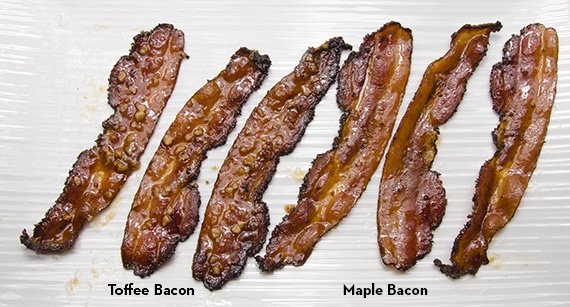

High quality websites are expensive to run. If you help us, we’ll pay you back bigtime with an ad-free experience and a lot of freebies!
Millions come to AmazingRibs.com every month for high quality tested recipes, tips on technique, science, mythbusting, product reviews, and inspiration. But it is expensive to run a website with more than 2,000 pages and we don’t have a big corporate partner to subsidize us.
Our most important source of sustenance is people who join our Pitmaster Club. But please don’t think of it as a donation. Members get MANY great benefits. We block all third-party ads, we give members free ebooks, magazines, interviews, webinars, more recipes, a monthly sweepstakes with prizes worth up to $2,000, discounts on products, and best of all a community of like-minded cooks free of flame wars. Click below to see all the benefits, take a free 30 day trial, and help keep this site alive.
Post comments and questions below
1) Please try the search box at the top of every page before you ask for help.
2) Try to post your question to the appropriate page.
3) Tell us everything we need to know to help such as the type of cooker and thermometer. Dial thermometers are often off by as much as 50°F so if you are not using a good digital thermometer we probably can’t help you with time and temp questions. Please read this article about thermometers.
4) If you are a member of the Pitmaster Club, your comments login is probably different.
5) Posts with links in them may not appear immediately.
Moderators